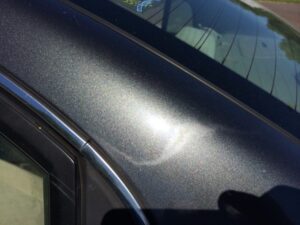
Axalta releases recommendation on blending clearcoat
By onAnnouncements
Axalta says that applying clearcoat to the entire panel is the traditional industry practice to restore a late model vehicle to its pre-accident condition and it is a requirement for warrantied systems supplied by the company, according to a recommendation document from the company.
“Collision repair centers receive requests to blend clearcoat within a panel versus applying the clearcoat to the entire panel,” the recommendation says. “The blend approach can produce a finish that appears acceptable to the customer at the time of delivery though the repair industry is aware the blend edge can become apparent within the remaining service life of the vehicle.”
One reason for increased visibility of the blend edge is the potential for weaker adhesion of the clearcoat in the blend area, the document says. The blend also has potential for poor weathering characteristics of the think clearcoat edge in the blend area. The result is the blend edge will look cloudy or dull with continued exposure to the sun and the elements.
“The practice of applying clearcoat to a back taped or back masked body line can generate similar failures as blending the clearcoat within the panel,” the document adds. “It is also important to note that most vehicle manufacturers do not recognize clearcoat blending or black taping/back masking on body lines as an accepted method for the execution of OEM warranty repairs.”
A January 2019 “Who Pays for What?” survey found 82 percent of respondents said leading insurers “always” or “most of the time” reimbursed work to extend clearcoat to its natural break.
Crash Network’s 2024 survey found 79% of insurers always or most of the time reimbursed for labor to apply clearcoat over an entire panel or as far as a molding or other breaking point to ensure the refinish work qualifies for lifetime warranty from the paint manufacturer.
In 2020 the Database Estimating Gateway worked to help clarify the topic from an estimating service’s perspective.
“In the P pages it states that the clear coat must carried to the nearest Break Point,” the user wrote regarding a 2018 Cadillac CT6 and the CCC P-pages. “On this particular case the damage is to one quarter panel and the clear coat needs to be taken UP on the roof and OVER to the adjacent Pillar/Quarter panel. According to the insurance adjuster’s interpretation, a gap between two panels is not necessary and the valley delineating the pillar from the roof is a proper location to break the clear coat.”
CCC responded to the user by stating that when refinishing a ‘Welded-On Panel’, the requirement is to refinish to the nearest ‘Break-Point’, because creating a ‘Blend-Line’ at a ‘Non-Break Point’ may result in ‘Refinish Deterioration’.
“Repairing the Quarter Panel and the Outer Surface of those parts will require some type of refinishing. The time necessary to perform this type of operation should be estimated after an on-the-spot evaluation of required procedure. MOTOR recommends these factors be considered before finalizing any repair cost estimate.”
CCC also quoted the Refinish Clear Coat Application entry referenced above. That P-pages item states: “Most major paint manufacturers recommend that when performing refinish repairs on an OEM base coat/clear coat or multistage finishes, the application of clear coat must be extended to the nearest panel edge or breakpoint to qualify for their lifetime refinish warranties.”
A February DEG inquiry asked what part of the quarter panel is considered “exterior,” “edging,” and “lock pillar.”
MOTOR responded that the exterior surface estimated refinish time is for the portion of the quarter panel surface that faces outside of the car when the door, trunk lid and or lift gate is closed.
The “lock pillar” is the jam/recessed area locate behind the door and the “edges & pockets” is the area located under or behind the Bumper, Trunk Lid and/or Lift Gate when closed.”
Axalta’s document notes that “it is critical to the quality of the repair to use the recommended products following the approved processes outlined in Axalta’s Technical Data Sheets.” More information is available on the Axalta Coating Systems website for full details regarding warranted systems and their related procedures.
Images
A failing C-pillar clearcoat blend. (Provided via Auto Damage Experts)
